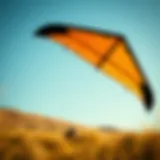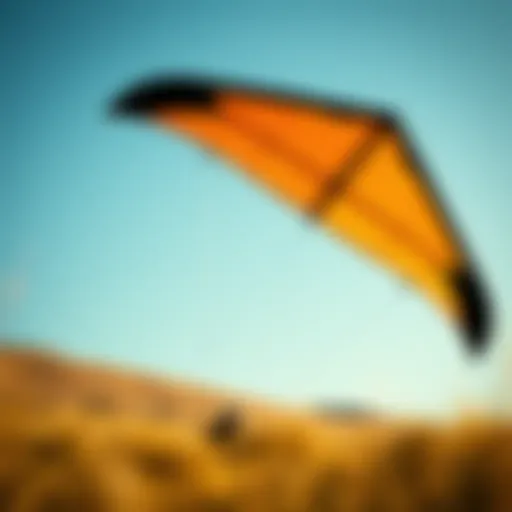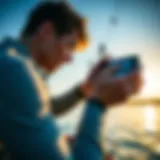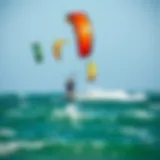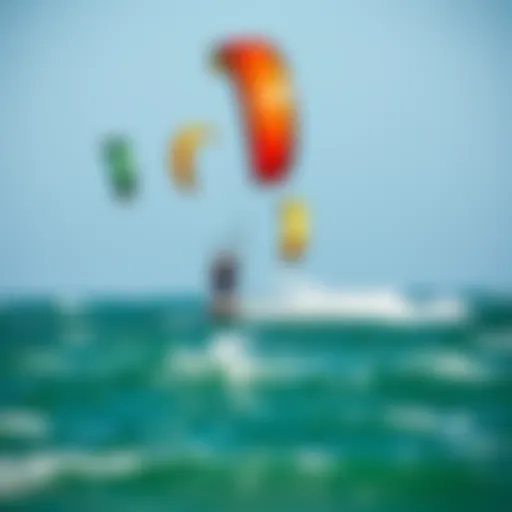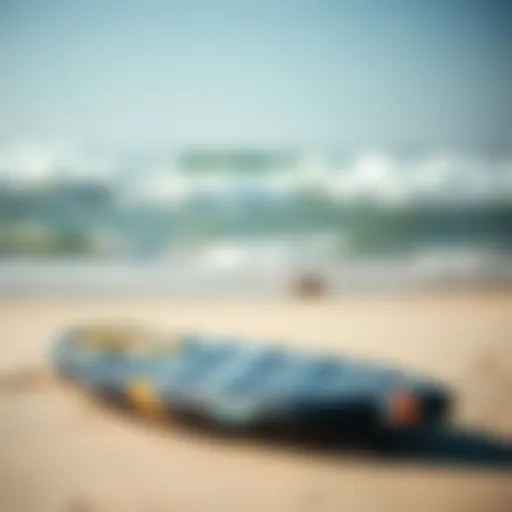Understanding Wing Foil Prices: Key Factors Explained


Intro
Diving into the world of wing foiling can feel like learning a new language—awesome, yet slightly daunting. With many choices out there, understanding the prices behind this thrilling gear is essential. Clarity in what shapes wing foil prices can save you from making costly mistakes and can ensure you choose the right equipment that aligns with both your aspirations and your wallet.
The market isn't just about flashy designs or brand names. Factors such as materials, advancements in technology, and regional market trends play significant roles in the price you see on a shelf or an online store. For kiteboarding enthusiasts, from novices to seasoned pros, understanding these elements is crucial. This guide aims to sift through the noise and provide a comprehensive view of the wing foil price landscape, helping you make informed decisions.
Gear Insights
Understanding wing foil prices often begins with a solid grasp of the gear itself. The price of a wing foil can greatly vary depending on its construction and quality.
Latest Gear Reviews
Brands tirelessly innovate to address performance and safety concerns in wing foiling. Some gear stands head and shoulders above others due to exceptional quality or cutting-edge technology. For instance, the Naish S26 Wing stands out for its balance in design and functionality while maintaining an impressive durability, which justifies its price tag. On the other hand, offerings like the Duotone Echo come with rave reviews for their responsiveness. Taking time to read reviews from other kiteboarders can illuminate the path to wise purchases.
- Performance: Look for wings that provide smooth lift and stability.
- Material Quality: High-end wings often use ripstop nylon, which can make a noticeable difference in performance.
- User Experience: Check forums on reddit.com to gauge the experiences of other users with specific brands and models.
Essential Gear for Beginners
For those just dabbling their toes in the wing foiling waters, understanding the essentials can help avoid splurging on unnecessary gear. The North Wings or Slingshot Fury are often recommended for novices, as they offer a good balance of price and performance. These options provide ease of use, making the learning curve less steep. Remember to also consider:
- Safety Equipment: Helmets and life vests should be a non-negotiable part of your kit.
- Foil Size: Overly small foils can be tricky, especially for beginners. Opt for sizes that accommodate your weight and conditions.
Setting a reasonable budget for your first gear is key, as investing too much can lead to buyer's remorse if your commitment waivers.
Techniques and Tips
Price may set the stage, but where your skill level comes into play is just as vital. It's not just about spending cash; it’s about owning the experience.
Advanced Tricks and Techniques
Once you’ve secured your gear and got the fundamentals down, you might find yourself itching to tackle some fancy moves. Tricks like the backflip or kite loop can be dazzling, but they require not just practice but also the right gear to execute safely.
- Practice: Regular drills help in mastering advanced tricks.
- Use Filters on Online Videos: Websites like facebook.com can be treasure troves of shared techniques from experienced riders teaching specific moves.
Safety Practices for Kiteboarders
As you push your limits, don't forget that safety should always remain a priority. The thrill is unmatched, but cutting corners can lead to mishaps. Always wear a safety leash and check your equipment before hitting the water.
"Safety isn’t just a habit; it’s a mindset."
Fostering a proactive approach to safety will set the foundation for your kiteboarding adventures, ensuring you can enjoy your newfound skills time and again.
The End
Understanding wing foil prices is not just a matter of comparing numbers; it’s about comprehension of the gear quality, brand reputation, and your own striking ambitions in kiteboarding. With the right insights and informed decisions, you can dive into the waves with confidence, knowing that you made the best choice for your needs and budget.
Prelude to Wing Foil Pricing
When diving into the world of wing foiling, it's essential to understand that pricing is not just a number on a tag. It reflects a multitude of considerations that can affect not only your purchasing decisions but also your riding experience. This introduction aims to peel back the layers of wing foil pricing, offering insights into why costs vary and how these variations impact your selection.
In a sport defined by rapid advancements and diverse equipment, knowing how to navigate the pricing landscape proves beneficial—not just for enthusiasts, but also for instructors and retailers. Discussing the importance of pricing in this context can help kiteboarders recognize correlations between gear quality, brand reputation, and performance.
What is Wing Foiling?
Wing foiling, a thrilling hybrid of kiteboarding and traditional windsurfing, utilizes a hand-held wing to harness wind power while riding above the water on a hydrofoil. Unlike other water sports, it allows riders to experience a unique sensation of gliding, almost as if they’re levitating. The combination of wing dynamics and the hydrofoil creates lift, enabling riders to fly above the surface without the drag typically associated with water sports.
The growing popularity of wing foiling has attracted enthusiasts from different backgrounds seeking a fresh way to engage with the wind and water. This rise in interest underscores the need for clear guidance on what drives pricing in this evolving market. Understanding the cost dynamics can lead to smarter decisions during purchasing, paving the way toward enjoyable and successful rides.
The Significance of Pricing in Gear Selection
When selecting gear for wing foiling, pricing acts as a key indicator of potential quality and performance. Often, but not always, higher prices correlate with better materials, superior construction, and enhanced features.
Consider some of the important factors:
- Material Quality: The materials used in creating a wing foil can significantly influence performance. For instance, foils made from carbon fiber tend to be lighter and offer improved responsiveness compared to those constructed from aluminum. This difference often shows in their price points.
- Construction Techniques: Different manufacturers employ varying construction methods, affecting durability and performance under different conditions—often reflected in the cost.
- Brand Reputation: Established brands may command higher prices, stemming from years of innovation and customer trust. Newer players might offer lower prices as they build their reputations and seek to attract consumers.
"Investing time in understanding these aspects not only leads to better purchases but enhances the overall enjoyment of the sport. A well-chosen piece of equipment can make all the difference on the water."
Grasping the essence of wing foil pricing arms you, the consumer, with knowledge that can guide your purchases effectively. By addressing these initial considerations, we pave the way for deeper examinations of the factors influencing wing foil prices throughout the rest of this guide.
Factors Influencing Wing Foil Prices
When diving into the world of wing foiling, understanding the factors that affect pricing is not just important, it's crucial. The cost of wing foils can vary widely, influenced by aspects like material, technological advancements, and the brand’s standing in the industry. Knowing these elements can save you time and money, ensuring you get your money's worth when making a buying decision. Let’s dig into the details that shape these prices.
Material Quality and Construction


Foil Materials
The materials used in constructing wing foils play a vital role in their performance and longevity. Most widely seen materials include aluminum, carbon fiber, and stainless steel. Aluminum is often a more budget-friendly choice, providing decent durability, whereas carbon fiber, albeit pricier, offers a much lighter and stiffer design for optimum performance. Some may argue that the upfront cost of carbon fiber is steep, but its lightweight nature leads to better handling and potentially easier gliding, making it a desirable choice for many.
Board Composition
Just like the foil, the board’s material impacts its performance. Common materials include epoxy, polyethylene, and fiberglass. Epoxy boards typically showcase superior strength and lower weight, appealing to professionals and enthusiasts alike. The downside? They can come with a higher price tag. Meanwhile, polyethylene boards may be the wallet-friendly option for newcomers. A unique feature of these materials is how they absorb shock, which can enhance comfort during rides in choppy conditions.
Durability Features
Durability in wing foils is non-negotiable, especially for those who intend to keep their equipment for multiple seasons. Certain designs incorporate reinforced seams and UV-resistant coatings, contributing to longer product life and better performance. A foil boasting such durability may be pricier upfront, yet it can ultimately offer significant savings by minimizing the need for frequent replacements. Durability features thus serve as both a selling point and a wise investment.
Brand Reputation and Influence
Established Brands vs. Emerging Brands
Brand reputation is another heavy hitter in the pricing game. Established brands, such as Naish or Slingshot, often command higher prices due to their proven track record in quality and performance. Newer brands, however, tend to offer competitive pricing to draw in customers. While opting for an established brand might come with assurance regarding product quality, exploring emerging brands can uncover fantastic options at lower prices. However, caution is warranted, as lesser-known brands may sometimes compromise on quality or customer service.
Customer Loyalty and Trust
The loyalty of customers to certain brands impacts pricing as well. Brands with a strong community presence often enjoy price stability because users trust their performance and service. In contrast, emerging brands might struggle to solidify their place in a crowded market, affecting their pricing strategies. When considering loyalty and trust, it’s worthwhile to also read reviews and gather insights from the riding community to help inform your purchasing decision.
Technological Innovations
Impact of R& on Costs
Research and development play an instrumental role in shaping costs. When a company invests in R&D to enhance materials or design new features, these advancements can lead to higher prices. However, they can also translate into improved performance and longevity, which justifies the investment. Customers willing to pay more for the latest innovations often gain a tangible advantage on the water, sparking a cycle of consumer interest and pricing increments.
Advanced Features and Their Price Implications
New features, like adjustable wingspans or specialized foils for different wind conditions, can significantly influence pricing. These advancements often come with a heftier price tag due to the intricacies involved in their engineering and production. While they offer superior performance, discerning watersport enthusiasts might need to weigh these features against what they truly need based on their skill level and riding style.
Market Trends and Demand Dynamics
Seasonal Demand Variations
Like many outdoor sports, wing foiling sees fluctuations in demand based on seasons. When the winds are right, everyone wants to hit the water, driving up prices for the latest gear. This seasonal surge can lead to spikes in both retail prices and resell prices. Understanding these cycles can help you determine the right time to invest in new gear, potentially saving you a few bucks.
Impact of Kiteboarding Popularity
In recent years, the increasing popularity of kiteboarding has cast a spotlight on wing foiling as a favored activity. This burgeoning interest can lead to heightened demand and price increases. Newcomers to wing foiling often spike sales, leading retailers to adjust their prices accordingly. When assessing the market, it is wise to stay updated with trends and shifts in popularity. This knowledge allows you to better strategize your investments and understand market dynamics.
"Knowledge is power when navigating the intricate world of wing foil prices."
Understanding these specific factors is paramount when you plan to invest in wing foil equipment. Knowing how each element influences prices can lead to smart decisions that fit both your current needs and future goals.
Price Ranges for Different Categories
Understanding the price ranges of wing foils is crucial for kiteboarding enthusiasts. Knowing where a product fits within the pricing spectrum can help you make informed decisions about what gear is right for you. Each category, whether it's entry-level, mid-range, or high-end, serves different needs, skill levels, and budgets.
When embarking on the journey of purchasing a wing foil, looking into price categories simplifies the decision-making process. It allows you to narrow your options significantly based on what you are willing to spend and what features you may require. Below, we delve deeper into what each of these ranges entails.
Entry-Level Wing Foils
Features and Specifications
Entry-level wing foils are designed for newcomers to the sport. They often feature a simple construction, focusing on ease of use. Key attributes include lightweight materials that make them easy to maneuver and a more forgiving design which helps beginners learn without much frustration.
These foils usually come with basic but reliable performance characteristics like stability and decent lift, making them great for those just starting out. However, they might lack some advanced features, such as adjustable wings or enhanced foiling technologies that you’d see in pricier models.
One notable aspect is that many models in this category are built from durable materials to withstand the wear and tear that comes with learning, but that can sometimes compromise performance compared to higher-end options.
Typical Price Points
In terms of cost, entry-level wing foils are generally accessible, with prices ranging anywhere from $600 to $1,000. The affordability makes these foils attractive for beginners who might not want to invest heavily before they know if they enjoy the sport. While paddling prices vary, the lower end of the spectrum captures interest without breaking the bank.
A potential drawback, however, is that spending too little might mean sacrificing quality. You might find that some very low-cost options have limitations in performance or longevity, possibly leading to a sense of dissatisfaction in the long run.
Mid-Range Options
Overview of Features
Mid-range wing foils bridge the gap between entry-level products and high-end gear. These models come with improved features like better material technology and design finesse, allowing for enhanced performance. They might include adjustable wings or better control systems to accommodate an evolving skill set.
For kiteboarders who have mastered the basics and are ready for a step up, this category offers significant enhancements. Added stability and faster response times are key benefits, catering to riders looking to develop their skills further.
Price Comparison with Entry-Level


Compared to entry-level options, mid-range wing foils can cost between $1,000 and $1,800. This price jump reflects the extra features and technology involved in the making of these foils. While you will need to shell out more dollars, many users find that this category offers a better balance between performance and cost, paving the way for a more enriched foiling experience.
However, buyers should consider their commitment to the sport before investing. If you’re still uncertain about long-term interest, jumping into this price range might feel risky.
High-End Wing Foils
Advanced Features Explained
High-end wing foils stand out for their incorporation of cutting-edge technology and design. These models often boast lightweight composite materials, computer-aided design for precision, and customizability that allows for tailored riding experiences. Features like advanced hydrofoil designs ensure greater lift and speed, making them ideal for skilled riders aiming to push their limits.
While these high-performing foils are typically reserved for experienced riders, they also signify the pinnacle of wing foiling equipment, delivering unmatched performance in various conditions.
Investment Justification
The price for high-end options typically starts around $2,000 and can go well beyond $4,000. At first glance, these prices might seem steep, yet they often pay off for dedicated enthusiasts. Investing in a premium foil can lead to longer-term satisfaction and superior performance on the water.
However, one should weigh the costs against how frequently they plan to engage in wing foiling and whether the high-end features will genuinely enhance their riding experience.
A high-quality wing foil can offer not just immediate performance benefits, but it can last for years with proper care, making it a potentially wise investment.
Ultimately, whether you’re at the entry, mid-range, or high-end of the pricing spectrum, understanding the value each category brings can aid considerably in making the right choice for your needs.
The Role of Retailers in Pricing Strategies
The world of wing foiling can be both exciting and daunting, particularly when grappling with the pricing strategies retailers employ. Retailers play a significant role in shaping the prices of wing foils, their accessories, and the overall purchase experience. The choices retailers make regarding pricing can influence consumer perceptions, sales volume, and ultimately, the user's experience in the sport. Understanding how retailers strategize around pricing helps enthusiasts make informed decisions about their purchases.
Pricing Models of Retailers
List Prices vs. Discounted Prices
When it comes to wing foils, list prices serve as the baseline. These are the initial prices that retailers set based on their costs, market value, and competitor pricing. Often, retail stores might use discounted pricing to attract buyers. This discounting has become a tactical exercise that draws in the bargain-hunter right off the bat.
While list prices may seem straightforward, they can often mask fluctuations based on demand, seasonality, and trends within the kiteboarding world. For a shopper, understanding that list prices can be negotiable or variable helps avoid the trap of thinking they must pay the listed amount. For many, snagging a deal or a discount can significantly sweeten the appeal of a purchase. However, buyers must remain cautious, as discounts may sometimes be a marketing ploy to draw attention yet not necessarily translate to value for money.
Impact of Online vs. In-Store Purchases
With the rise of e-commerce, the purchasing landscape has shifted dramatically. Online retailers offer a competitive edge in terms of price transparency, allowing customers to easily compare prices across different platforms without stepping foot in a store. This convenience can significantly aid in price-conscious shopping. On the flip side, in-store purchases allow customers to physically assess product quality and get a feel for the gear before completing a transaction.
However, an often overlooked aspect is the role of customer service in brick-and-mortar stores. Knowledgeable staff can influence buyer decisions through personal recommendations, while online platforms may rely on product descriptions and reviews. Therefore, before diving into an online transaction, buyers might want to visit local shops, as this interaction could provide invaluable insights, which shapes their ultimate purchasing decision.
The Influence of Sales and Promotions
Seasonal Sales
The wing foiling market isn’t static; it ebbs and flows with the seasons. Retailers often capitalize on this by hosting seasonal sales. These events can offer significant discounts, particularly at the end of a season or when launching new models. These sales create opportunities for budget-conscious riders to upgrade their gear while saving some cash, making it a win-win situation.
The uniqueness of seasonal sales lies in their timing and marketing strategies. Buyers can find themselves in a position to snag high-quality equipment at a fraction of the price. However, impatience can be a buyer’s downfall. Sometimes, the lure of discounts can lead to hasty decisions, prompting individuals to buy gear that might not meet their specific needs or performance expectations.
Bundling Offers and Discounts
Another savvy strategy employed by retailers is bundling offers. These promotions often combine several products at a reduced price when purchased together. For instance, a wing foil kit might include the wing, the board, and essential accessories, making it a convenient option for newcomers.
The beauty of bundling is that it simplifies the purchasing process for consumers. Instead of piecemealing together equipment, buyers can secure everything they need in one fell swoop. However, consumers should tread cautiously. In some cases, bundling can lead to buying items that might not be necessary or desired, potentially lowering the perceived value of the purchase.
"The choices retailers make about their pricing strategies can influence everything from consumer perception to overall sales volume, making it crucial for buyers to be informed about their options."
To wrap it all up, grasping the nuances of retail pricing can be beneficial for anyone looking to invest in wing foil gear. Whether considering where to shop or how to take advantage of sales, being well-informed sets the stage for savvy purchases. Keeping these strategies in mind can ensure that kiteboarding enthusiasts make choices in line with both their budget and needs.
Evaluating Value Beyond Price
When it comes to wing foil purchasing, price often is the first thing that grabs attention, yet there's so much more under the surface. It's crucial to evaluate the overall value you are getting for your money. Evaluating value beyond mere price tags opens the door to discerning the long-term benefits and costs associated with your gear. Making a well-informed decision involves looking at not just what you pay today but how that investment stands the test of time, and it’s about striking a balance between quality, performance, and financial outlay.
Understanding Cost-Effectiveness
Long-Term vs. Short-Term Costs
In the realm of wing foiling, understanding the distinction between long-term and short-term costs can be a game-changer. Short-term costs refer to the immediate spend you make when purchasing the gear, while long-term costs encompass maintenance, repair, and eventual replacement expenses over time. Often, high-quality materials might demand a heftier initial outlay but can save you bucks down the road due to their durability. A solid wing foil from a reputable brand might set you back a couple of hundred bucks more than a cheaper alternative, but if you consider the lifespan and performance under various conditions, it usually proves to be a wise investment.
When you see a bargain, it can be tempting as a snapshot appeal, yet those budget options might have performance setbacks that land you back at the drawing board sooner than you would hope. It’s vital to weigh these factors with full knowledge of your usage intentions.
Resale Value Considerations
Resale value is another key aspect to consider in your purchasing puzzle. Some brands and types of wing foils hold their value remarkably well, especially if they are in demand. Should you decide to upgrade or change your setup, having a gear with better resale value means you can recoup a good amount of your investment. This results in a lower net cost overall.
However, not all wing foils have the same resale trajectory. Less established brands may not fare as well on the second-hand market. It's prudent to do some research and look into what others are fetching for similar equipment. This consideration can significantly affect your bottom line as you cycle through gear aligned with your evolving needs.
Personal Experience and Reviews


Importance of User Reviews
In today’s interconnected world, personal experiences shared among users can be incredibly informative. Customer reviews serve as a trove of insights. Using them wisely can tip you off about potential issues or highlight extraordinary performance traits that a manufacturer’s marketing spiel might gloss over. Real experiences from fellow enthusiasts can help you sort the wheat from the chaff, ensuring you don’t end up with a product that doesn’t meet your expectations.
When seeking user reviews, pay attention to reliable platforms where enthusiasts congregate, such as Reddit threads or specialized forums. Keep an eye out for users who detail their experiences over time, as this context can often illustrate how the gear holds up in various conditions and usage scenarios.
Expert Recommendations
Leaning on expert recommendations can also guide you tremendously. Industry professionals often have a wealth of knowledge, derived from extensive testing and experience. Unlike layman's opinions, expert suggestions can delve deeper into the reasons behind the performance of certain wing foils.
It can be beneficial to follow leading kiteboarding magazines or websites with expert reviews, as they often conduct their own rounds of evaluations on the latest equipment. Similarly, checking YouTube channels dedicated to kiteboarding gear can give you visual insight as well. These resources may point you toward investments that are truly worth considering, based on objective evaluations rather than just marketing sleight-of-hand.
"Making an informed decision involves not just price but evaluating the full worth of your chosen gear. Keep long-term costs and resale potential in mind."
Ultimately, a comprehensive approach to evaluating value beyond price can significantly enhance the purchasing journey in the wing foiling world, ensuring you make selections that stand the test of time.
Budgeting for Your Wing Foil Purchase
When it comes to wing foiling, understanding your budget is as crucial as knowing the difference between a wing and a foil. This segment of the guide highlights the importance of thoughtful financial planning before diving headfirst into your purchase. The reality is that wing foiling can be an investment, not just in terms of the gear itself but also in the accompanying costs that come with enjoying this exhilarating sport.
Establishing a budget helps you eliminate the guesswork. It allows you to pinpoint what you can realistically spend, avoiding the heartache of falling in love with gear that is way beyond your means. When you set a clear budget, you’re on the road to a more informed and satisfying buying experience.
Setting a Realistic Budget
Assessing Personal Financial Limits
Assessing your personal financial limits is about taking a practical look at your finances and figuring out how much you can set aside for wing foiling. It’s about knowing where you stand. Start by reviewing your monthly income and expenses. Identify discretionary spending that you might be willing to cut back on, like dining out or that latte every day.
One key characteristic of this process is its alignment with long-term financial health. By understanding your financial boundaries, you can enjoy your new hobby without the nagging worry of unpaid bills hanging over your head. This approach is not just practical but also ensures you face your new passion without financial strain, which can often detract from the thrill of the ride.
A unique feature of assessing personal financial limits is that it encourages a more deliberate purchase, allowing you to invest in quality gear rather than settling for cheaper options that might lead to extra expenses down the line. A thorough self-assessment can steer you toward making choices that are financially sound.
Incorporating Additional Costs
Buying your first wing foil is exciting, but it’s not just about the price tag on the gear. Incorporating additional costs means taking into account all the other expenses that come with your new endeavor. Apart from the foil and board, there are accessories, safety gear, and even travel costs to consider.
A key characteristic of incorporating these additional costs is the holistic view it provides. Recognizing these expenses upfront prevents the dreaded surprise of realizing you can’t afford the full experience after your initial purchase. Knowing what you’ll need—from a life vest to a carry bag—helps you avoid any budgetary rug-pulls.
The unique aspect of factoring in additional costs is that it cultivates informed decision-making. While your wing foil itself may be within budget, forgetting to plan for those must-have extras could result in later scrambling or cutting corners on safety. This foresight is invaluable for anyone aiming to enjoy their time on the water fully.
Financing Options for High-End Purchases
When thinking of splurging on high-end purchases, it’s critical to know your financing options. After all, not everyone has thousands of dollars just sitting around waiting to be spent on top-notch equipment. Understanding how to finance your gear can open up doors to better quality items that might otherwise be out of reach.
Accessory Costs
Accessory costs are often overlooked while budgeting for wing foiling but should never be underestimated. These costs include items such as impact vests, helmets, and even high-quality straps designed specifically for wing foiling. They can add up quickly and should be accounted for in your total budget.
One key characteristic of considering accessory costs is that they enhance your safety and overall experience on the water. Purchasing the right accessories not only ensures your enjoyment but helps prevent injuries that could sideline you from the sport. Plus, quality gear generally holds up better over time.
A unique feature of accessory costs is that they can often be bundled, potentially leading to discounts or special offers when purchasing from the same retailer. This can save money in the long run and prevent the annoyance of having to buy accessories at different times.
Instalment Plans and Layaway Options
Many retailers now offer financing options such as instalment plans or layaway to help make high-end gear more accessible. An instalment plan allows you to pay for your new wing foil over a set period in defined payments. Layaway works a bit differently, requiring you to pay upfront before taking your purchase home, but it’s really helpful for budgeting.
Understanding this aspect is vital for anyone interested in spreading out their costs while still getting the gear they want. It enables riders to acquire better equipment without the initial financial burden of paying in full upfront.
The key benefit of these options is flexibility. You can adjust your payments to fit your financial situation, allowing for less stress and more enjoyment! However, it’s crucial to read the fine print—some plans may have interest rates or fees that can complicate what seems like an easy payment arrangement.
Remember: Knowledge is power when it comes to budgeting for your wing foiling adventure. Consider both initial and ongoing costs to ensure a fulfilling experience that is financially sound.
Epilogue: Making an Informed Decision
When it comes to purchasing wing foils, the act of making an informed decision is not just a beneficial practice; it’s a crucial step towards ensuring a satisfying, enjoyable experience on the water. The complexity of wing foil prices involves a plethora of elements that can easily confuse the uninitiated. Understanding these aspects helps not only in making a choice that fits the budget but also aligns with personal needs and preferences.
Before reaching for the wallet, it’s important to reflect on key considerations. Are you a novice or do you have a wealth of experience? Will this gear be used for casual outings, or do you have aspirations of participating in competitions? These factors significantly influence what you should look for in terms of quality and features, which ties directly back to price.
Moreover, recognizing the value of research cannot be overstated. The more informed you are about your options, the more capable you become of distinguishing between what’s essential and what might be just extra fluff on more expensive models. As you navigate the myriad of offerings, remember that an informed decision not only saves you money but also enhances your overall kayaking adventure.
Recapping Key Considerations
When breaking down the essentials that can impact your purchase, consider these points:
- Personal Skill Level: Your experience with wing foiling can greatly affect the type of gear suitable for you. Beginners might prioritize ease of use, while seasoned enthusiasts may seek performance.
- Budget Constraints: Set a clear financial boundary that encompasses not just the foil itself but also necessary accessories and potential maintenance costs.
- Brand Reputation: While it’s tempting to fall for trendy brands, sometimes lesser-known options provide great quality without the brand markup.
- Technology vs. Tradition: Some models offer advanced features that enhance performance but come at a premium price. Determine if these features realistically align with your riding style.
Emphasizing Research and Due Diligence
In today’s fast-paced market, making a snap decision may lead to buyer's remorse. To avoid that pitfall, dedicate time for research and due diligence.
- User Reviews: Platforms like Reddit or dedicated sports forums provide genuine community feedback, which can be invaluable in assessing the reliability and performance of various products.
- Expert Reviews and Recommendations: Consult articles and videos from trusted influencers in the wing foiling space. They often highlight details that casual consumers might overlook.
- Test Before You Buy: If possible, find rental options or demo days. Getting hands-on experience can help clarify what you need vs. what you want.
Essentially, approaching your wing foil purchase with thorough research equips you with knowledge that translates into a wise investment, fostering enjoyment every time you're out on the water.


